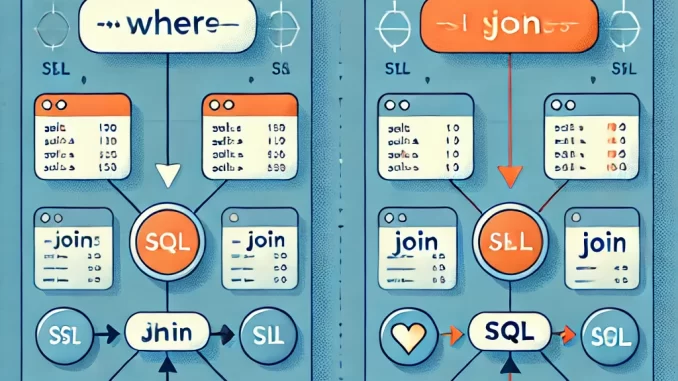
WHERE vs. JOIN in SQL: How to Filter Data Effectively
Structured Query Language (SQL) is a powerful tool for managing and querying ,handling databases. One of the important aspects of SQL is filtering data efficiently to retrieve relevant records. Two commonly used methods for filtering data are WHERE and JOIN. While both can be used to refine query results, but they serve different purposes and have impact in distinct ways. In this article, we will study about the the differences between WHERE and JOIN, and how to use them effectively.
Understanding WHERE in SQL
The WHERE clause is used to filter records from a table based on a specific conditions. It is primarily used where we have SELECT, UPDATE, and DELETE statements. The WHERE clause helps in retrieving only the rows that satisfy a given condition.
Example of WHERE Clause:
SELECT * FROM employees
WHERE department = ‘Sales’;
In this example, the query retrieves all employees who work in the Sales department.
Key Use Cases of WHERE:
- Filtering data within a single table.
- Applying conditions to numerical, text, or date columns.
- Using logical operators (AND, OR, NOT) for multiple conditions.
- Utilizing comparison operators (=, >, <, BETWEEN, IN, LIKE) to refine results.
Understanding JOIN in SQL
The JOIN clause is used to combining rows from two or more tables based on a related column between them. Instead of filtering individual records, JOIN helps in merging datasets to provide a complete view of related information .
Example of JOIN Clause:
SELECT employees.name, departments.department_name
FROM employees
JOIN departments ON employees.department_id = departments.department_id;
In this query, we combine data from the employees and departments tables using the common department_id column.
Types of SQL JOINs:
- INNER JOIN: Returns only matching rows from both tables.
- LEFT JOIN (LEFT OUTER JOIN): Returns all rows from the left table and matching rows from the right table.
- RIGHT JOIN (RIGHT OUTER JOIN): Returns all rows from the right table and matching rows from the left table.
- FULL JOIN (FULL OUTER JOIN): Returns all rows when there is a match in either table.
WHERE vs. JOIN: Key Differences
| Feature | WHERE | JOIN |
| Purpose | Filters rows based on conditions | Combines data from multiple tables |
| Used With | SELECT, UPDATE, DELETE | SELECT (to merge tables) |
| Performance | Can be slower if used for filtering after a JOIN | Can improve performance by reducing data early |
| Primary Function | Eliminates unwanted records | Retrieves related records from different tables |
When to Use WHERE vs. JOIN
- Use WHERE when:
- Filtering records from a single table.
- Applying conditions after combining tables using JOIN.
- Working with aggregate functions (HAVING can be used for filtering groups).
- Use JOIN when:
- Merging data from multiple related tables.
- Retrieving information from different datasets using foreign keys.
- Reducing redundant data storage by normalizing tables.
Example: Combining WHERE and JOIN
You can use WHERE and JOIN together for more refined queries:
SELECT employees.name, departments.department_name
FROM employees
JOIN departments ON employees.department_id = departments.department_id
WHERE departments.department_name = ‘Sales’;
This query joins the employees and departments tables, then filters only those employees who belong to the Sales department.
Performance Considerations
- JOIN before WHERE: It’s generally recommended to apply JOIN first, then filter using WHERE to minimize the number of records processed.
- Indexing Matters: Proper indexing on join keys can significantly improve query performance.
- Avoid Unnecessary JOINs: If filtering data from a single table, using WHERE alone is more efficient.
Conclusion
Both WHERE and JOIN are essential tools in SQL for data retrieval and filtering. Understanding their differences and knowing when to use them can ensure efficient query execution and better performance. Use JOIN to combine tables and WHERE to filter records effectively. By applying these techniques wisely, you can optimize SQL queries for speed and accuracy.
If you have any favorite SQL optimization trick? Do Share your thoughts in the comments below!

Leave a Reply